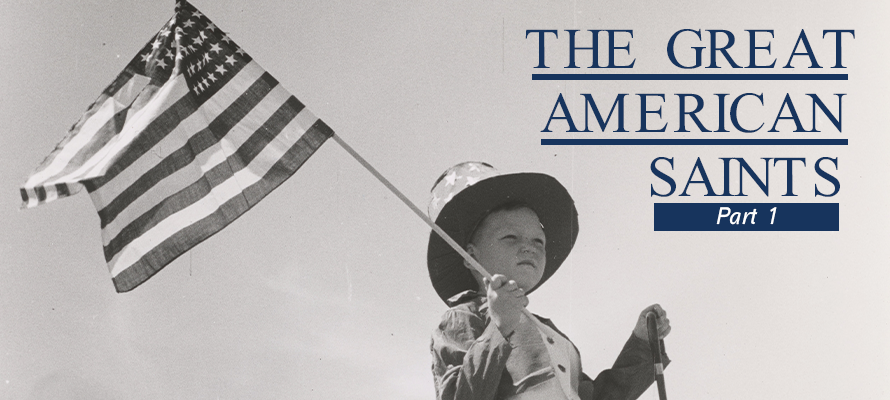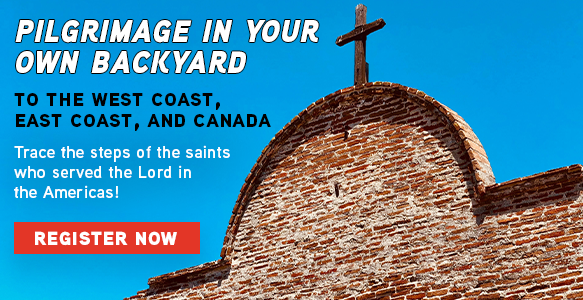

St. Kateri Tekakwitha
- Born: 1656 in upstate New York
- Died: April 17, 1680 (age 24)
- Beatified: June 22, 1980 by Pope John Paul II
- Canonized: October 21, 2012 by Pope Benedict XVI
- Feast day: July 14
- Patron of: ecologists, loss of parents, people in exile, people ridiculed for their piety, and Native Americans
Kateri was born to a Christian Algonquin mother who was captured by the Iroquois and given to the chief of the Mohawk clan in 1656. She lost both parents and her little brother to smallpox when she was about 4 years old, which also left her with facial disfigurement and failing eyesight. Later adopted by her uncle, who succeeded his brother as chief, Kateri would often find herself listening to the Jesuit missionaries when they visited the high tribes and villages. Often ridiculed by her family and peers for following the teachings of the black coats (Jesuits), Tekakwitha spent many days isolated from others in prayer and at the age of 19, on an Easter Sunday converted to Catholicism. She took the name Kateri, which is the Mohawk form of Catherine, from St. Catherine of Siena.
Kateri was known to be a highly skilled worker, completing her chores quietly while in prayer and diligently with purpose. The tribe would punish her for refusing to work on Sundays, and withheld food and water on those days. At the age of 22, Kateri ran away to a Christian village which was over 200 miles away. While on this journey, she professed a vow of virginity, even before knowing that it was part of religious life. Upon her arrival, she wanted badly to start her own religious order for women, but her priest advised against it, saying she was too young and sickly. Kateri eventually accepted living an ordinary life practicing extreme fasting while offering up the suffering of her self-inflicted pain; this practice was used as penance for the conversion of her Indian nation. She had seen the torture and death of many captives and felt her pain and suffering was needed to spiritually save her nation. At her death, those nearby witnessed as her scarred face became perfect like a young child, and her lips formed a faint smile.
She was given the name, Tekakwitha as a young girl, which means “putting things in order,” and it’s amazing that she was able to embrace Christianity while enduring such physical and emotional pain. She did have the support of what Christians and all people require- the support of a community. Kateri had a good mother, faithful priests, and a few good Christian friends. Amazingly, all present in a civilization hostile to Christianity, her faith was able to grow through the age-old Christian triad of prayer, fasting and almsgiving. She was devoted to God, Jesus, and the spirit, and practiced extreme self-discipline and suffering for her people who routinely rejected and humiliated her. Kateri found great joy in serving her ungrateful native brothers and sisters, and truly believed that this fulfillment was a gift from God. She is the patron saint of environmentalists, loss of parents, people in exile, and people ridiculed for their piety.
“The poverty I am threatened with does not scare me, because so little is needed to give to the necessities of this miserable life and my labor could provide for it and I could always find some rags to cover me.”
Prayer to St. Kateri
Saint Kateri Tekakwitha, our elder sister in the Lord, discreetly you watch over us; may your love for Jesus and Mary inspire in us words and deeds of friendship, of forgiveness, and of reconciliation. Pray that God will give us the courage, the boldness and the strength to build a world of justice and peace among ourselves, and among all nations. Help us, as you did, to encounter the Creator God present in the very depths of nature, and so become witnesses of life. With you, we praise the Father, the Son and the Spirit. Amen. Holy founders of the Church in North America. Pray for us.

St. Elizabeth Ann Seton
- Born: August 28, 1774, in New York
- Died: January 4, 1821 (age 46)
- Beatified: March 17, 1963 by Pope John XXIII
- Canonized: September 14, 1975 by Pope John VI
- Feast Day: January 4
- Patron of: Catholic Schools, seafarers, and widows
Elizabeth was born to a socially prominent couple in New York City. Her father, Dr. Richard Bayley was a surgeon who attended to immigrants disembarking from ships onto Staten island. He also cared for the many New Yorkers that suffered from yellow fever. The epidemic lasted 9 years, killing thousands. Elizabeth’s mother was the daughter of an American Church of England priest, and was raised in what would eventually become the Episcopal Church.
Elizabeth’s mother died when she was just 3 years old, shortly after giving birth to her younger sister, Catherine. Catherine passed away about a year later. Elizabeth’s father remarried Charlotte Barclay soon after and they had 5 other children together. Charlotte introduced Elizabeth to charitable works at a young age and would often take her to deliver food and medical supplies to the poor. Sadly, Charlotte and Dr. Bayley’s marriage eventually led to a separation, where Elizabeth and her older sister were rejected by Charlotte. Elizabeth endured a time of darkness while grieving the absence of her second mother and filled her days reading scripture which reinforced a sense for God’s true presence.
While living in the country with other family members, Elizabeth was introduced to the beauty of nature, which is often found in her poetry and other early writings. At the age of 19, Elizabeth married William Seton, a wealthy import businessman, and moved into a beautiful home on Wall Street. She continued her former stepmother’s ministry to the poor, sick and dying in impoverished neighborhoods, and eventually became the treasurer of The Society for the Relief of Poor Widows with Small Children.
Several years and 5 children later, William’s import business was hit with bankruptcy. With the United Kingdom’s blockade of France and too many of his ships lost at sea, along with the worsening of William’s tuberculosis, the Seton family lost their Manhattan home and found themselves living with Elizabeth’s father on Staten Island. In order to save William’s life, his doctors urged he be shipped off to a warmer climate in Italy. Elizabeth and their eldest daughter tried to join him there but got stuck in quarantine for a month, where William sadly passed away without his family. Overwhelmed by grief, Elizabeth was comforted by William’s Catholic Italian business partners, whose faith eventually leads to her conversion.
Widows of social standing in those days often ran academies in their home to sustain their families, but once news of her Catholic conversion spread, many parents removed their daughters from her care. After many other difficulties trying to support her family, Elizabeth accepted an invitation from a priest to help start Saint Joseph’s Academy and Free School in Emmitsburg, Maryland, an institution for Catholic girls, beginning the first Catholic parochial school system in the United States. She was now referred to as Mother Seton and adopted the rules of the Daughters of Charity, which was co-founded by St. Vincent de Paul and St. Louise de Marillac.
Elizabeth Seton had no extraordinary gifts, she was neither a mystic or stigmatic, nor did she state prophesy or speak in tongues. She accomplished great things and grew in spiritual strength due to her belief in the real presence of our Lord in the Eucharist, her devotion to our Blessed Mother, and becoming convicted through scripture that the Catholic Church leads back to the apostles of Christ.
“We must pray without ceasing, in every occurrence and employment of our lives- that prayer which is rather a habit of lifting up the heart to God as in a constant communication with Him.”
Prayer to St. Elizabeth Ann Seton
Lord God, you blessed Elizabeth Seton with gifts of grace; as wife and mother, educator and foundress, so that she might spend her life in service to your people. Through her example and prayers may we learn to express our love for you In love for our fellow men and women. We ask this through our Lord Jesus Christ, your Son, who lives and reigns with you and the Holy Spirit, one God, for ever and ever. Amen.
Check out the other two great American saints on December 3rd!




